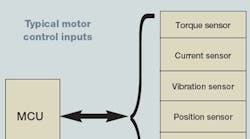Over the years, the direction of semiconductor technology has proven to be a fairly good compass for mapping the direction of motion control. In the early days, the development of the transistor led to simple on-off controllers. Then came op amps and analog control, followed by microcontrollers and modern software- based digital control. The next big leap, based on today’s microcontroller refinements, will be in areas of flexibility, connectivity, and precision.
Speed and precision
One of the biggest trends in microcontrollers is the move to 32-bit architectures. These chips, now the norm, herald a future of unprecedented machine precision. Another trend — microcontrollers incorporating digital signal processor (DSP) and reduced instruction set computing (RISC) technology — will have a similar effect, as will the trend to faster central processor units (CPUs). Chips with faster CPUs also promise tighter control, where several variables (position, speed, torque, temperature, pressure, current, voltage) can be measured and processed in real time.
Besides performance, higher CPU bandwidth also delivers an economic benefit. Controllers that can calculate motor shaft position in real time, for example, can eliminate several sensors and their associated cost. As CPU performance becomes more affordable, other system components may be eliminated as well.
Additional CPU horsepower will also pave the way for more sophisticated failure detection and monitoring techniques in motion systems. As a result, tomorrow’s controllers will be more fault tolerant. If there is a fault, controllers will assume a safe state or provide an orderly shutdown in advance of a catastrophic failure. Additional CPU bandwidth can also be used to administer other (non-motion) system functions.
Flexibile future
Another area where semiconductor trends will impact motion and machines is flexibility. Today’s programmable microcontroller units (MCUs) employing on-chip flash memory will be the brains behind a new breed of machines that automatically transform themselves through software rather than hardware. Such machines will adapt their behavior and control attributes on-the-fly in response to local information as well as commands and updates coming in over standard communication links.
MCUs with on-chip flash memory also means that a single integrated circuit (IC) can be used in multiple applications and systems, economizing both development and production costs. With flash, any controller can have access to multiple control functions and strategies. This allows such developments as “smart” motor controls that accommodate a variety of motors and applications. System designers can select the specific software necessary for the application via a PC or other interface.
Peripheral vision
As MCU core processing functions improve, so too are on-chip input/ output (I/O) peripherals. Increased sophistication here means more robust types of motion control. Dual independent analog-todigital
conversion units, for example, can simultaneously sample two motor current phases, while the third is calculated in real time by the CPU. More advanced pulsewidth modulator (PWM) circuits are also available, giving machines control over their entire speed range. These newer PWM peripherals can change modulation methods at any time without disturbing motor operation.
Many MCU peripherals have actually been designed with motion control in mind. One such example is a time processor unit (TPU) integrated onto various MCU derivatives. Having multiple programmable timing channels, a TPU is a microengine that executes microcode stored in read-only memory (ROM), implementing such functions as input capture and out-put compare, free-running counters, stepper motor control, fast quadrature decode, and synchronized PWM. TPUs also let users develop custom functions, storing them in random access memory.
Network news
Of the many trends in chip technology, however, none is bigger than connectivity. The rise of the Internet and wide-area, distributed, enterprise-level information technology (IT) systems is an outgrowth of chip-level connectivity. This silicon-based communication highway penetrates the deepest levels in motion control systems, letting devices communicate over great distances and effectively share information.
Communication is just one of the benefits when motion components link to wide-area networks. The sharing of control and status information also opens the door to distributed machine control, diagnostics, adaptive response, and software- based configuration. If a problem develops anywhere in a networked plant — an interruption in material flow, for example — every machine, every motor, in fact, can compensate, thus optimizing overall system control.
Tough talk
When it comes to connectivity, motion control systems present a special challenge because they require more robust communications than a typical office network. Factors such as electromagnetic compatibility, interference, vibration, shock, operating temperature, communication rate, and electrical noise are all more extreme in motion control systems, and are a potential cause of system or network failure.
Fortunately, modern communication standards, such as Controller Area Network (CAN), handle these sorts of applications well, and are inexpensive to boot. Many MCUs with on-chip CAN are available today, providing compact, cost-effective solutions for networked motion control applications.
For wider area networks, Ethernet continues to grow as the dominant standard. The huge amount of available infrastructure and software makes this an attractive solution for enterprise and factory-level networking. By integrating Ethernet, CAN, and other networking protocols, standard ICs will form the fabric of all-encompassing multiplexed networks. Easier to design, more reliable, and less costly to maintain than traditional point-topoint wiring systems, these networks will make motors, machines, and factories less dependent on hard-wired connections, and more dependent on underlying system software.
